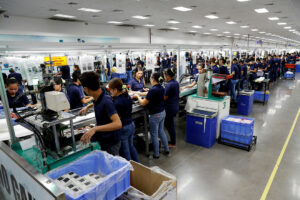By Aubrey Rose A. Inosante, Reporter
PHILIPPINE manufacturing expanded for a 14th month in a row in October, but the pace of growth slowed month on month amid a softer rise in new orders and output, S&P Global said on Monday.
At the same time, manufacturing firms ramped up hiring, with job creation hitting an 88-month high.
The S&P Global Philippine Manufacturing Purchasing Managers’ Index (PMI) stood at 52.9 in October, slowing from the 27-month high of 53.7 in September. This was the second-fastest reading since January 2023.
An above 50 PMI reading signals an improvement in operating conditions, while a reading below 50 indicates a deterioration.
“October PMI data indicated a slight easing in — but still solid — growth across the Filipino manufacturing sector. The expansion in new orders was again robust, allowing goods producers to raise their output again,” Maryam Baluch, economist at S&P Global Market Intelligence said in a report.
The Philippines’ PMI — a composite single-figure indicator of manufacturing performance — has posted an above 50 reading every month since September 2023.
The Philippines logged the highest PMI reading among the five Association of Southeast Asian Nations (ASEAN) countries in October, followed by Vietnam (51.2) and Thailand (50).
Meanwhile, Malaysia (49.5), Indonesia (49.2), and Myanmar (48.4) recorded contractions in October.
Philippine PMI was also above the region’s average reading of 50.5, which was unchanged from September, S&P Global said.
The headline PMI measures manufacturing conditions based on the weighted average of five indices. It includes new orders (30%), output (25%), employment (20%), suppliers’ delivery times (15%) and stocks of purchases (10%).
S&P Global said Philippines PMI data reflected a “sustained and solid” improvement in manufacturing operating conditions in October.
Despite a slowdown, new orders grew for the 15th consecutive month, while output expanded for a seventh straight month.
“The recent increases outpaced their series averages, driven by a growing customer base that strengthened underlying demand trends,” it said.
Stronger demand allowed manufacturing firms to significantly raise staffing levels in October.
“Filipino goods producers ramped up hiring, with the recent wave of job creation marking the most significant increase since mid-2017,” it said.
With more workers, manufacturing firms managed to address the slight buildup of backlogs and keep up with current production requirements.
At the same time, the improvement in demand allowed companies to boost purchasing activity, but at a weaker pace than the previous month.
“Firms stated that higher prices of raw materials often dissuaded firms from purchasing inputs,” S&P Global said.
This prompted firms to use their existing inventory for orders, with pre-production inventories falling for the first time since February. Stocks of finished goods were depleted for a third month in a row, and at the sharpest rate since January 2022.
Supply chains continued to be stretched in October, with shortages of raw materials due to port congestion.
“Firms revealed supply-side challenges, with material shortages resulting in longer delivery times, and cooling buying activity. It was also one of the key factors for rising input prices, which was further exacerbated by the depreciation of the peso against the dollar,” Ms. Baluch said.
S&P Global noted the rate of input price inflation rose to an eight-month high in October.
The peso closed at P58.10 per dollar on Oct. 31, weakening from the P56.03 close on Sept. 30.
Manufacturing firms are positive that current demand trends will continue in the next 12 months.
“Nonetheless, firms remain optimistic with more than half of respondents anticipating expansion in the year ahead,” Ms. Baluch said.
‘BRIGHT SPOT’“The Philippines is the only real lone bright spot in terms of recent momentum, though its September pop to 53.7 cooled to 52.9 last month and the impact of this still-sturdy gain won’t really be felt regionally due to the country’s relatively small manufacturing sector,” Pantheon Macroeconomics said in an e-mailed statement.
For the ASEAN region, Pantheon said the result was “softer than we expected” as the manufacturing sector recovered from typhoons.
“The generally improved PMI rates in the last two months can be attributed to pent-up demand which had been released by lower inflation rates as the easing of interest rates,” Leonardo A. Lanzona, an economics professor at the Ateneo de Manila University told BusinessWorld via Facebook Messenger.
He noted that companies typically boost production in the months ahead of the holidays in anticipation of stronger demand.
“As the country’s manufacturing base increases and the Christmas season completes by the end of the year, expect the growth rate of PMI to be much lower,” Mr. Lanzona said.
However, he noted supply-side issues, including the lack of skills and the poor adaptation of new technologies, continue to weigh on the manufacturing sector.
“Manufacturing may continue to grow given increased local demand during the holidays and foreign demand as trade liberalization takes further effect,” John Paolo R. Rivera, president, and chief economist at Oikonomia Advisory & Research, Inc. told BusinessWorld via Viber Message.
Meanwhile, Ma. Teresita Jocson-Agoncillo, executive director at the Confederation of Wearable Exporters of the Philippines, said wearables manufacturing remains slow as of end-September.
“We are at an average — 3% to 5% growth vis-a-vis at the same period last year. The recent wage hike increase across major regions — Regions 3, 4A and B, Region 7, and NCR — had an impact on Spring-Summer 2025 orders. These orders were directed to more competitive ASEAN countries,” she told BusinessWorld in a Viber message.

